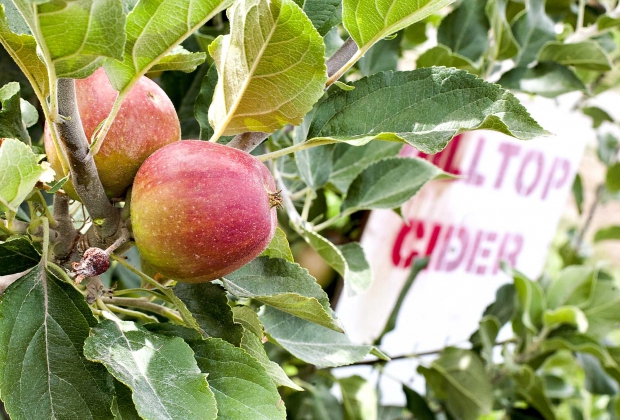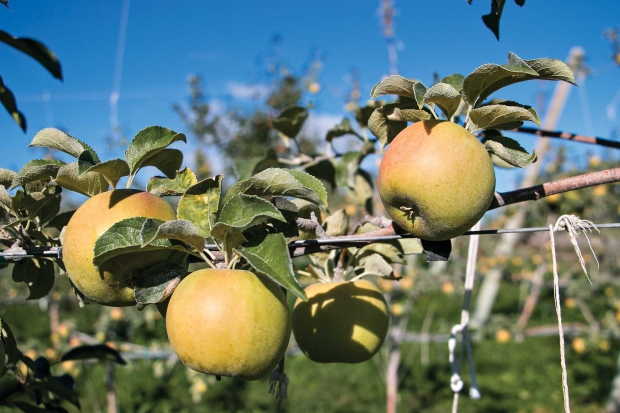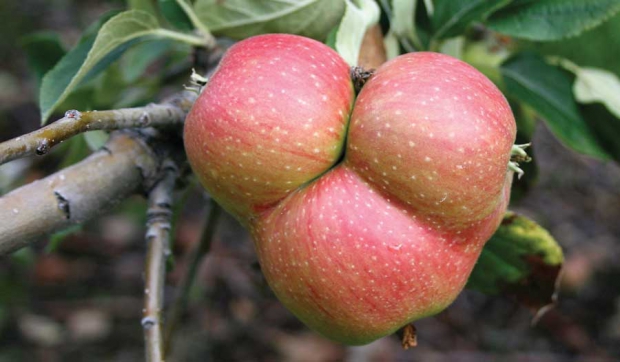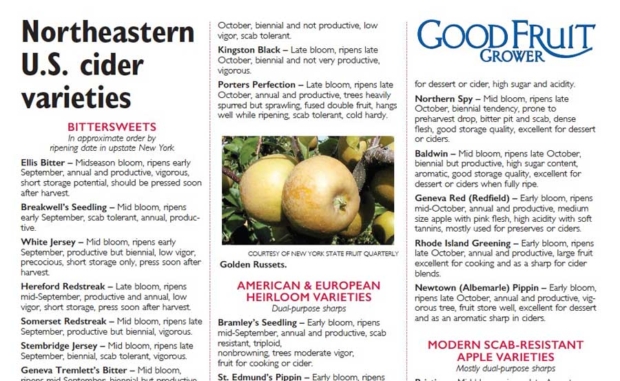
Tieton Cider Works’ “Hilltop Cider” orchard in Yakima, Wash., in 2014.(TJ Mullinax/Good Fruit Grower)
Two key growers in the cider apple market are weighing in for Good Fruit Grower on commonly used cider apple varieties in the U.S., including bittersweet and bittersharp varieties, heirloom apples from the U.S. and Europe, and modern scab-resistant apples capable of selling well in both dessert and cider markets.
Steve Wood has grown, grafted or fermented more than 200 cider apple varieties since 1985.
The co-owner of Poverty Lane Orchard and Farnum Hill Ciders of Lebanon, New Hampshire, Wood sells 15,000 gallons of hard cider and 30,000 to 40,000 gallons of sweet cider annually.
Craig Campbell, founder and owner of Tieton Cider Works, and his wife Sharon have a 55-acre ranch in Washington’s Yakima Valley, where they grow cider and heirloom varieties in organic orchards.
They grow more than 40 varieties of cider apples and pears for perry and claim to have the largest such acreage in Washington.
Wood and Campbell relate their experienced observations on the characteristics and performance of some of these apple varieties, listed alphabetically:
Ashmead’s Kernel
The tree is “difficult,” Wood says. “You think you have it settled and it throws a huge lateral.” Its buds are prone to winter injury. As a dessert apple, it is very acidic. It produces a flowery cider with a lot of acid and a lot of sugar.
Campbell calls it a great dual-purpose apple that is grower friendly and a steady producer. Harvested in mid-October, Campbell grows most of this variety on a V-trellis. It can be used for a single variety cider and is his wife, Sharon’s, favorite pie apple.
Calville Blanc d’Hiver
The tree is vigorous; it wants to grow like a vase, Wood says. It has thick wood; its strong laterals are sweeping and upright and it is spurry when it matures. The apple is excellent for cooking and has very strong lobes. For cider, it’s a very good sharp that adds very little character to cider beyond acid.
Chisel Jersey
Wood says Chisel Jersey has flat laterals and weak leaders, and that it’s all over if the laterals choke out the leader. The fruit has harsh tannins that soften in fermentation and is very like Dabinett, except for its more aggressive tannins.
Cox Orange Pippin
A fruity apple that adds acid, Wood says.
Dabinett
Campbell has had winter injury problems with this variety, which has low vigor, but he likes the juice quality when blended with a bittersharp.
The variety flowers late and harvests late for Wood, with strong, direct and structured tannins. Somewhat biennial, the trees are fairly easy to thin. The apple is small. The tree is not vigorous, but grows well if allowed.
Wood also says the variety requires attentive pruning, because it loses its leader easily to competition. The laterals are flat. It is moderately susceptible to fire blight.
Egremont Russet
Wood calls this an “indifferent” variety for dessert and cider purposes.
Ellis Bitter
Ellis Bitter is a good early to mid-season apple that Wood says stores a little better than some believe. It gets very ripe and does not fall apart. The fruit is juicy and has mid-range, fairly aggressive and harsh tannins. It’s one of the most vigorous varieties he’s ever seen. It’s not precocious but it is productive.
Gold Rush
Wood says Gold Rush is a good, neutral source of acidity.
Golden Russet
Wood calls this variety a fruit bomb with high sugar and moderate acidity. It presents many different fruits in fermentation and is great eating fresh. The tree is vigorous with lots of blind wood. It is very hard to get it to fruit efficiently.
Campbell says the dual-purpose apple is a tip bearer and good producer that they harvest in early October.

Golden Russet cider apples in Tieton Cider Works cider orchard in Yakima, Wash., in 2014. (TJ Mullinax/Good Fruit Grower)
Harrison
A tip-bearer, it is Campbell’s largest planted cider variety. Fruit buds on one-year wood. It’s a steady producer, makes a great single variety cider. It shows medium vigor on Malling 9, harvested in mid-October.
Harry Master’s Jersey
The tree shows good vigor, has strong central leaders and fairly vigorous laterals, Wood says. It has soft, round, full tannins and is very fruity.
Kingston Black
Campbell harvests this variety in early October. His trees are not overly vigorous, growing on M9.337. He thinks it is a great bittersharp for use as a single variety cider.
For Wood, Kingston Black is a tree he loves to hate. “It does what it wants to do. It throws three shoots at the sky. Bend them 90 degrees and you get suckers up to the sky. It just wants to throw growth to the sky.”
Wood said the variety is very hard to maintain a center leader. Over the years, it fruits from the outside in; when it settles, it fruits toward the center. He agrees that it’s best used as a single variety cider because it overwhelms other varieties in blending. It has a distinctive diacetyl character, a butterscotch flavor and cantaloupe, decaying leaves and forest-floor aromas.
Newtown Pippin
It stores forever, Wood says.
Northern Spy
Wood says the variety provides good acid and grows like a triploid.
Porter’s Perfection
Campbell says this variety is a good producer, harvested in early October, and bears a lot of fused fruit.

Porter’s Perfection is a bittersharp apple variety that originated in Somerset, England, during the 19th century. (Geraldine Warner/Good Fruit Grower)
Pristine
“I cut these trees down with pleasure years ago,” Wood says.
Rhode Island Greening
A variety Wood buys when he’s short on acid varieties.
Somerset Redstreak
It’s the most biennial variety Wood says he has ever seen but produces a beautiful fruit with soft, round tannins that is very low in acid.
St. Edmund’s Pippin
Wood calls St. Edmund’s Pippin a passable dessert apple, but he doesn’t like it for cider.
Stoke Red
Stoke Red is biennial but very productive in the on-year, Wood says. The tree shows wispy growth and is a little bit of a tip-bearer. It loses its central leader if the laterals overtake it and produces a lot of thin wood. The fruit is very acidic and very bitter.
Campbell picks Stoke Red in early October and is not very vigorous on M9 337.
Sundance
Wood: It is a good source of acid.
Yarlington Mill
A decent producer, Campbell says. It shows moderate vigor on M.9, but it has posed fire blight problems.
Wood calls it a vigorous growing tree with blind wood. It’s fire blight-susceptible. The apples fill in as the tree matures. The soft apple has beautiful soft tannins and should be milled and pressed immediately after harvest because it doesn’t store well. It goes well with Dabinett in the same tank.
– by Dave Weinstock
Learn more about Northeastern U.S. cider varieties in our special pull-out from the June 2016 issue (PDF).







Leave A Comment